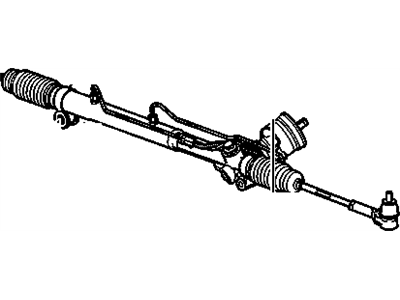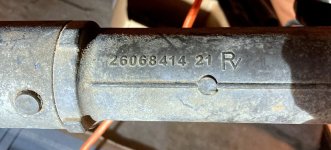After determining the correct rack was used for your model year
Pull fuse for Magnasteer and drive to see any difference
Assure no air in fluid due to the swap
GM MAGNASTEER
Unlike EVO power steering systems, Magnasteer does not use an orifice valve to reduce pressure to the steering gear.
There is no solenoid or stepper motor involved. Instead, Magnasteer uses magnets to assist or resist steering input.
The Magnasteer control valve assembly is mounted on the steering rack in the same location as a regular control valve assembly on an ordinary power rack. Inside the base of the Magnasteer unit is a large electromagnetic coil. Just above the coil is an inner and outer pole assembly with a permanent magnet in the center.
Steering feel is varied by changing the strength and polarity of the magnets, which, in turn, is controlled by changing the pulse width and direction of the current to the coil.
On 1996 and 1997 applications, Magnasteer has its own separate control module. But on 1998 and newer applications, the Electronic Brake Control Module (EBCM), which also oversees the operation of the anti-lock brake system, handles the Magnasteer control function.
On most applications, the only input the control electronics uses for Magnasteer is the vehicle speed sensor. At zero mph, a negative current of approximately two to three amps flows to the Magnasteer coil.
This causes the magnets to repel each other, which in turn allows more deflection in the torsion bar inside the spool valve assembly. This increases fluid flow through the spool valve to the steering gear for maximum power assist when it is needed most.
As vehicle speed increases, current flow to the Magnasteer coil is gradually reduced. At about 45 mph, current flow to the coil hits zero and Magnasteer has no effect on the amount of power assist (which is determined only by the torsion bar and pump flow).
Above 45 mph, the direction of current to the coil is reversed and continues to gradually increase, up to a maximum of about three amps at 75 to 85 mph. Reversing the polarity of the coil causes the magnets to attract each other, which has the effect of stiffening the torsion bar.
This reduces the amount of deflection in the torsion bar that normally occurs when the wheels are steered and causes an increase in steering effort for better road feel and high-speed steering stability.
On some Magnasteer systems, such as that used in the Corvette, the Electronic Brake Traction Control Module (EBTCM) also looks at input from a steering wheel position sensor to determine if more or less steering assist is needed under certain driving conditions. The main purpose here is to reduce oversteer by reducing assist when excessive G-forces are detected.
Compared to conventional power steering systems, Magnasteer gives the driver a much broader range of power assist with a smooth transition from low to high speed. The system can be recalibrated to modify steering feel using a Tech 2 or equivalent aftermarket scan tool.
There are three settings: factory, firmer and less firm. Just follow the scan tool prompts and that is all there is to it.
In 1998, a second generation "Magnasteer MAGe" system was introduced on some GM vehicles. This version of the system does not use a permanent magnet, but uses a redesigned electromagnet that has one pole mounted on the input shaft and the other on the pinion shaft.
At low speed, there is no current flow through the electromagnetic coil. The level of steering assist depends solely on the calibration (stiffness) of the torsion bar. As speed increases, current flow to the coil is gradually increased up to a maximum of several amps to decrease assist and increase steering effort. Magnasteer MAGe uses vehicle speed as its only input, so there are no changes in steering effort during sudden steering maneuvers.
ELECTRONIC STEERING DIAGNOSIS
Problems with electronic variable-assist systems include all of the same things that can go wrong with a conventional power steering system (leaks, center wear in the steering gears, pump & hose failures, etc.), plus problems with the control electronics including the vehicle speed sensor circuit, the solenoid valve and control module. Accurate diagnosis, therefore, is essential to minimize warranty returns.
Most of these systems provide diagnostic fault codes that can be accessed with a voltmeter, test light or scan tool to pinpoint the nature of the fault (if the fault is electronic rather than mechanical or hydraulic).
If power to the solenoid or control valve actuator is lost, the valve keeps the bypass circuit closed so full power assist is provided under all driving conditions. The only indication of trouble, therefore, might be a loss of road feel and/or increased steering sensitivity at highway speeds.
It is important to remember that variable-rate power steering only reduces the amount of pressure that reaches the steering gear at higher road speeds. The only way it could reduce power assist at low speed would be in the unlikely event the actuator or solenoid valve failed in the open position. This could cause a noticeable reduction or loss of power assist.
On GM Magnasteer racks, loss of current to the magnetic coils would cause a loss of power assist at low speed. Coil resistance can be checked with an ohmmeter, and should read about two ohms. An infinite (open) reading indicates a bad coil (requires replacing the rack, since the coils are not serviceable). Checking for shorts between both sides of the coil assembly and rack housing is also recommended.
The system does have self-diagnostic capability, but there is only one fault code: C1241 (Magnasteer circuit malfunction). The code is set if the module detects an open or a short in the coil circuit. If this code is present, the Magnasteer system is disabled and will not vary the steering effort as vehicle speed changes.
The C1241 body code can be read with a Tech 2 or equivalent scan tool. The Tech 2 tool can also be used to perform a Magnasteer function test. The test varies the current to the coil so you can check for a change in steering effort when turning the steering wheel.
Replacement racks for variable-assist power steering applications are available with or without an EVO control solenoid. As long as the original EVO control solenoid is working OK, it can be removed and installed on the replacement rack to save your customer a few bucks. There is no need to replace the whole rack if only the EVO solenoid valve is defective.
On GM Magnasteer applications, the whole rack must be replaced if the rack or control unit is defective because the Magnasteer unit is part of the rack. Handle with care because the permanent magnets inside the Magnasteer valve assembly and connector are fragile and can be easily damaged.
NOTE: The Motorist Assurance Program recommends changing the power steering fluid every 50,000 miles, or any time components such as the steering rack, pump or hoses are replaced.





